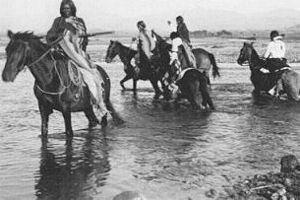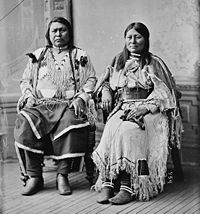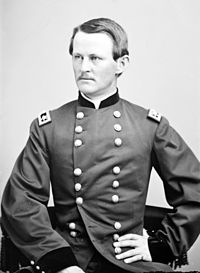- Battle of Milk Creek
-
Battle of Milk Creek Part of the White River War, American Indian Wars 
Ute warriors crossing a stream in 1878.Date September 29-October 5, 1879 Location Milk Creek, Colorado Result United States victory Belligerents  United States
United StatesUte Commanders and leaders  Wesley Merritt
Wesley Merritt
 Thomas Tipton Thornburgh †
Thomas Tipton Thornburgh †Ouray
Captain JackStrength ~700 ~250 Casualties and losses 13 killed
44 wounded19-37 killed
7 missingJicarilla War
Point of Rocks - Wagon Mound - Cieneguilla - Ojo Caliente Canyon
Provo War
Fort Utah
Walker War
Fountain Green - Nephi - Gunnison Expedition - Gunnison Massacre
Tintic War
Black Hawk's War
Salina Canyon - Squaw Fight - Pipe Spring - Manti - Circleville - Scipio - Gravelly Ford - Thistle Valley - Diamond Fork - Last Raid
White River War
White River Agency - Milk Creek
Bluff War
Ute Mountain - Cottonwood Gulch
Bluff Skirmish
Posey War
Blanding - Comb RidgeThe Battle of Milk Creek began on September 29, 1879, in northern Colorado, and lasted several days as the United States Army and warriors of the White River Ute tribe engaged in what was to be one of the last true battles of the so-called Indian wars.
Contents
Background
The origins of the Ute War were deeply rooted in the Manifest Destiny doctrine, an unalterable belief that God willed the boundaries of the United States be expanded, through force if necessary, from sea to sea and perhaps even all of North and South America. Its first great milestone was the Louisiana Purchase and it continued through the first decade of the twentieth century, particularly after the American Civil War. Nathan Meeker, characterized[by whom?] as obdurate and patronizing Indian Agent at the White River Ute Agency in Colorado, was the very embodiment of this imperial philosophy.[citation needed]
In the years preceding the Milk Creek battle and Meeker Massacre, the idealistic, but ambitious and debt-ridden, Meeker had taken the advice of friend and mentor Horace Greeley to go west, where he made an ill-fated attempt to establish a utopian socialistic community at the site of present-day city of Greeley, Colorado. Failing there, he then secured the Indian Agent position through political connections.
The Ute tribe, ensconced protectively among the spires of the Colorado Rocky Mountains, were among the last of the native American horse nomads to be destructively encroached upon by settlers. Most importantly, horses had, in fact, gained totemic significance among the Utes. After the civil war each succeeding governmental administration, bowing to the acquisitiveness of the railroad, land and mining barons, had attempted to effectuate control of the natives by destroying these economic bases. Nathan Meeker with messianic zeal embarked upon a program to replace the Ute horses and bison with plowshares and seeds.
The Utes, passionately attached to their horses and culture, dug in their heels. In the late summer of 1879 some of the band's young men left the reservation for a buffalo hunt. Meeker considered this a flagrant violation of agency rules and then repeated his demand that the band kill some of their horses[1] and ordered their race track plowed under. Tempers flared, culminating in a brief but portentous shoving match or fist fight between the Ute medicine man, Canalla and Meeker.[2] The Agent reacted by wiring Department of Interior superiors for assistance. The Department, having no enforcement power, then contacted the War Department and no less a person than General William Tecumseh Sherman for federal troops to quell what he considered to be the initiation of an Indian uprising.
Battle
Opening of hostilities
Orders descended from General Sherman in Washington to General Philip Sheridan in Chicago to General George Crook in Omaha to send a force to back Meeker expeditiously. That force consisted of a mixture of Fort Steele infantry, located east of Rawlins, Wyoming and two companies of cavalry from Fort D.A. Russell outside Cheyenne to the White River Agency over 180 miles distant. On the morning of September 21, 1879 a column of about 175 men and 25 wagons departed Fort Steele for Rawlins under the command of Major Thomas Tipton Thornburgh, a West Point graduate and Civil War officer.[3] By September 25, Thornburgh having been given only the vaguest of orders and possessing an equally imprecise knowledge of the situation at the Agency, dispatched a message to Meeker informing him of the column's location and requesting Meeker meet him on the trail for a strategy session. On or about this same date cavalry outriders reported seeing mounted Ute warriors in the distance; the buffalo hunters under Nicaagat, or Captain Jack, a young part-Apache sub-chief at the agency who had been raised by Mormons and served as a scout under General Crook.
Eventually, Jack and some of his men approached Thornburgh and asked where the column was headed. When told it was headed to the agency, the tribesmen sullenly departed only to return that night and inform the Major that to do so would be a treaty violation. Instead Jack suggested a combined party of five Utes and five officers ride to the agency for a meeting with Meeker. Fearing a trap, Thornburgh declined. Ironically, Meeker, in a last-ditch attempt to head off the looming catastrophe, had dispatched a rambling letter to Thornburgh requesting, as Jack had wanted, that he, Thornburgh, halt his column outside the reservation and, proceed to the agency with a small number for a peace conference.[4] Thornburgh then provided a no less murky response, written and verbal, the latter leading the Indians to conclude he was moving forward with his entire command. Thornburgh’s scout, Joe Rankin reported seeing about twenty-five mounted warriors on the ridge in front of the column where the road crests a pass and dips into Coal Creek Canyon, an excellent place for an ambush.
Unknown to Thornburg his response to Meeker and subsequent actions had panicked the Utes at the agency who remembered all too clearly the 1864 Sand Creek Massacre. They immediately assembled a fighting force of 200 to 300 warriors, mounted and afoot, armed with a wide variety of weapons. On September 28, more messages and warnings were sent and received by all three parties. Communication was chaotic and events had taken on a life of their own.
On September 29, Thornburgh led his column spearheaded by two companies, one from the 5th Cavalry and one from the 3rd Cavalry two miles ahead of the wagon train of supplies and infantry with another company of cavalry in a distant reserve position. He approached Milk Creek, a thick, meandering alkali slough slicing an arroyo through a terraced, mile wide park bordered by steep ridges covered with pine, cedar, oak brush and sage. This, in fact, was the point of no return. They were about fifteen miles from the agency and, to the Utes, clearly in violation of the treaty provisions. Concealed by the ridges, brush and trees they had dispersed and waited.
Tension within Thornburgh’s ranks was palpable with many of the soldiers probably remembering the Little Big Horn disaster only a little over three years ago. Because the expedition was not to be construed as offensive the men were issued only forty rounds of ammunition. A reconnaissance team comprising about four officers including Major Thornburgh and two scouts probed cautiously toward the crest of Yellow Jacket Pass seeing as they proceeded mounted warriors passing back and forth along its crest. At almost exactly twelve o'clock noon Lieutenant Samuel Cherry waved his hat either in peaceful greeting to the Utes or to signal Major Thornburgh. A shot rent the still mountain air followed by a brief silence and then fusillades from both sides.
Siege
Though the battle lasted for nearly a week the stage was set for the duration within the first two hours with the Utes racing to out flank and segment the column and the soldiers struggling to consolidate a defense. Because neither side expected a full-on shooing match neither had developed plausible strategies nor tactics. The Indians thought that blocking the soldiers at the reservation boundary would cause them to reverse direction and go home.[5]Thornburgh, because of muddled communications thought a show of force on the Ute reservation would suppress any burgeoning uprising. The Ute chief Colorow has been documented as commenting at the time that a key objective is to capture the wagons containing the food supply which would sustain the Indians and starve the soldiers into a retreat as opposed to retribution and annihilation . Even Jack standing on a hill side smoking his pipe watching the battle unravel pondered its suddenness and complete lack of a tactical objective other than halting the troop train.[6]But if retreat was the overall Ute strategy they were quickly defeating that purpose by the tactic of killing all the cavalry horses and draft animals and unleashing such a hail storm of bullets that it provided the soldiers no opportunity for a fighting withdrawal.
Thornburgh, dashing about organizing a defensible position with wagons, animals and infantry on an adobe bench one hundred yards above Milk Creek fell mortally wounded from a bullet wound to his chest. The battle was less than an hour old. Command passed to the wounded Captain Scott J. Payne, who tried to pass it on to Captain Lawson the latter refusing saying Payne was still able to command. Within hours of the first shot fired at Milk Creek the Utes remaining at the White River Agency received word of the battle and ran amok killing and burning, sealing as their fate.
Virtually all of the expedition's deaths happened before 5:30 the evening of September 29 when the foundations of the defenses were established. At that time those defenses consisted of a circle of remaining wagons within which 150 defenders had dug another circle of seventeen trenches each two to four feet deep and approximately seventy-five feet long. These revetments were reinforced with boxes and sacks from the wagons and dead animals. From the first the animals had been targeted by the Indians at the end of the first day's fighting consisted of approximately 127 mules and 183 horses.[7] The Ute sharpshooters aimed to wound many of the animals inside the enclosure so their agony and stampeding would cause even more chaos and injury among the troops. Those deaths coupled with the humans killed in action inadvertently provided the Utes one of their next hopeful tactics; capitulation by gasification.
Rescue
However, the Utes had incompletely surrounded the trapped soldiers and during the night couriers were dispatched north for reinforcements which arrived three days later in the form of Captain Francis Dodge and thirty-five men of D Company 9th Cavalry plus two civilians.
Though haled by the besieged as saviors, the men of the 9th Cavalry simply joined in the siege with food and ammunition. On October 5, twenty officers and 234 men[8] the 5th cavalry led by Colonel Wesley Merritt from Fort D.A. Russell near Cheyenne, Wyoming arrived after a forced march of 170 miles. Chief Jack, realizing no good purpose could be served by continuing the engagement surrendered with a piece of white tent canvas.
Aftermath
Ultimately, the army failed to prevent the Meeker Massacre and the Utes lost their horses and lush mountain reservation and in 1881 were removed to the Utah desert. The army and militiamen lost thirteen dead and forty-four wounded, most of them in the first twenty-four hours of the engagement. Eleven soldiers were awarded the Medal of Honor and approximately thirty were decorated for heroic conduct in one of the most decorated battles of the Indian wars.[9] Chief Jack estimated that nineteen warriors were killed and seven were unaccounted for[10] though other sources say the Utes lost thirty-seven killed in both the Meeker incident and the battle.[11][12] [13]
References
- ^ Sprague, Marshall, Massacre: The Tragedy At White River, University of Nebraska Press, 1957, p.176
- ^ Marsh, Charles S., People of the Shining Mountains, Pruett Publishing Company, 1982, p. 90
- ^ Miller, Mark E., Hollow Victory, 1997, University Press of Colorado, Niwot, Colorado, p. 22
- ^ Miller, pp. 43-44
- ^ Marsh, Charles F., People of the Shining Mountains, Pruett Publishing Company, Boulder, CO, p.95.
- ^ Miller, p. 61
- ^ Miller, pp. 176-185
- ^ Miller, pp. 127-128
- ^ Miller, p. 181
- ^ http://www.amazon.com/Unearthing-Battle-Milk-Creek-September/dp/0615176224
- ^ http://www.cgsc.edu/carl/resources/csi/santala/santala.asp#m1
- ^ Miller, p. 176
- ^ Miller, Mark E, Hollow Victory, University Press of Colorado, 1997
Coordinates: 48°34′39″N 109°6′26″W / 48.5775°N 109.10722°W
Categories:- 1879 in the United States
- Battles involving Native Americans
- Battles involving the United States
- Conflicts in 1879
- History of Colorado
- Military history of the United States
Wikimedia Foundation. 2010.


